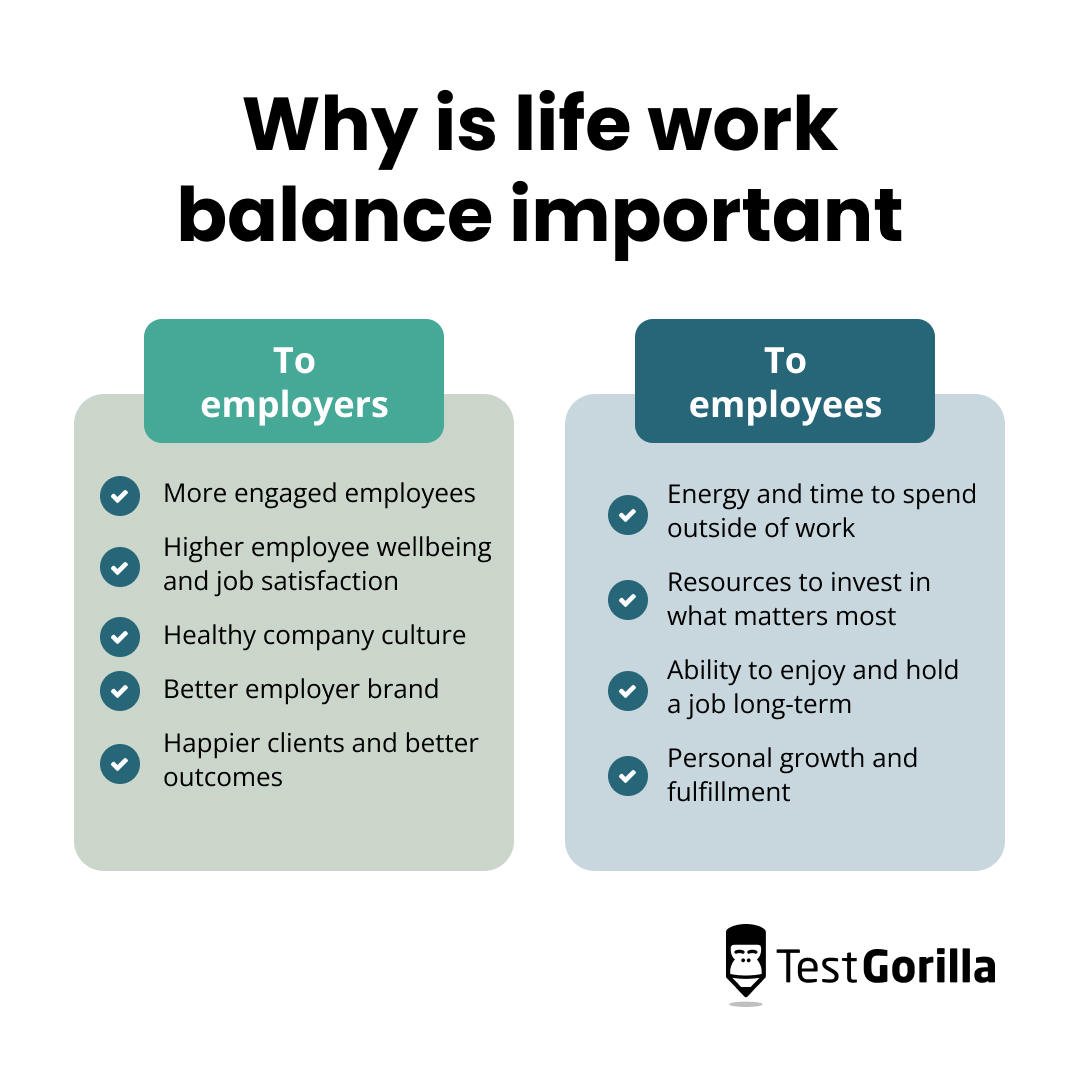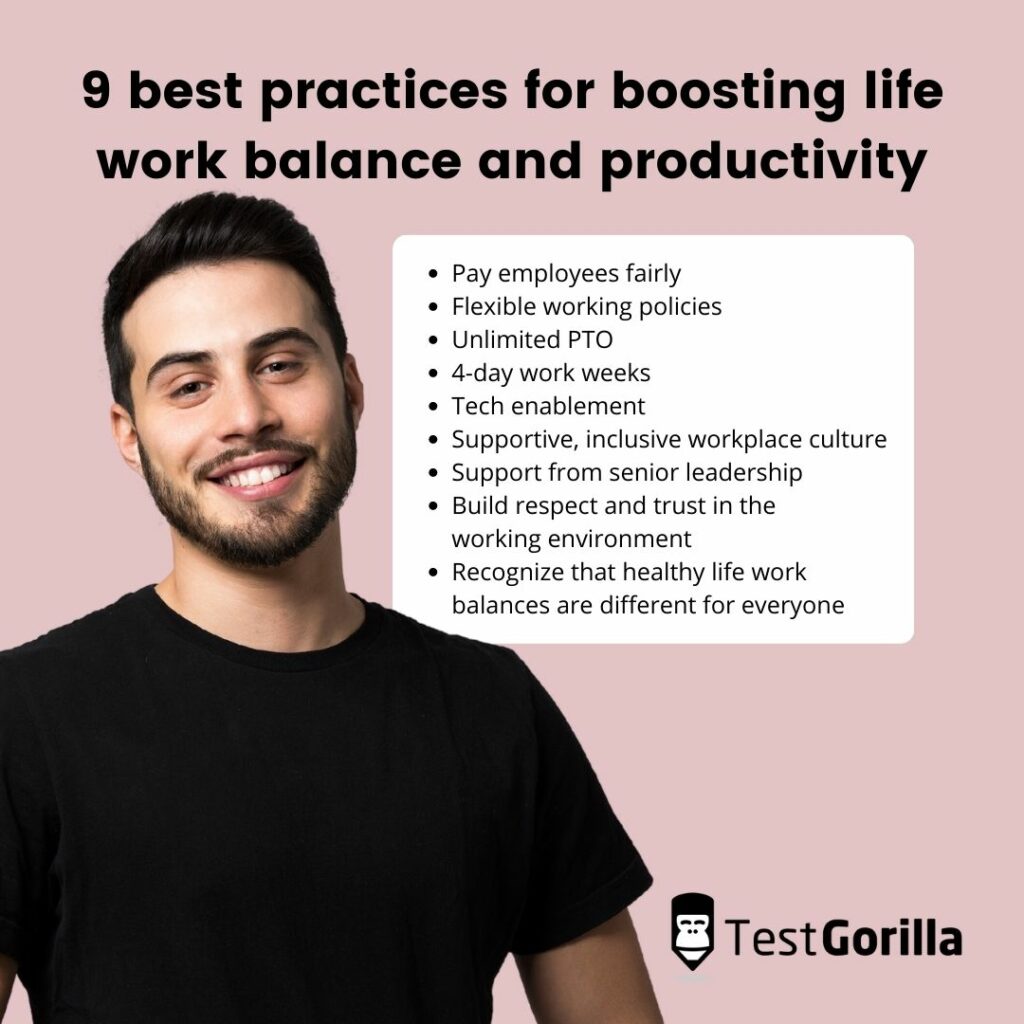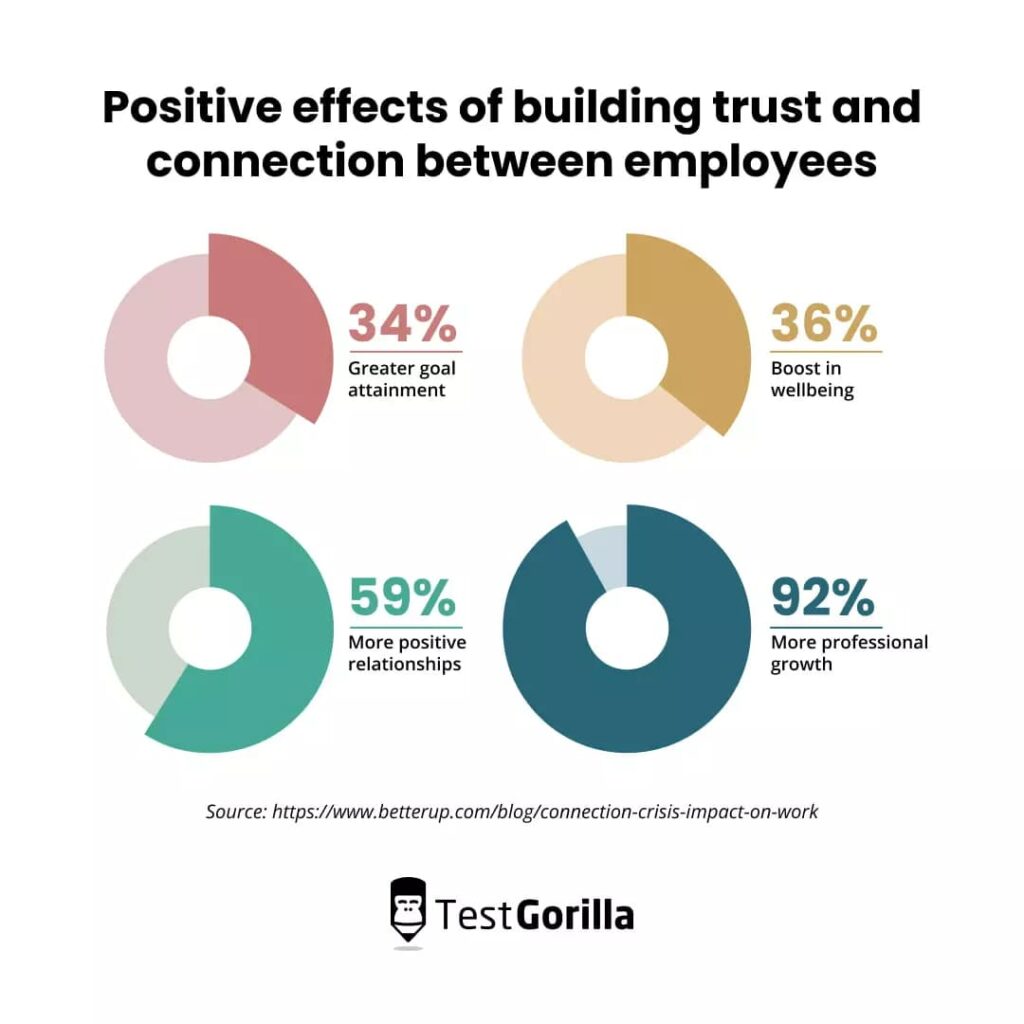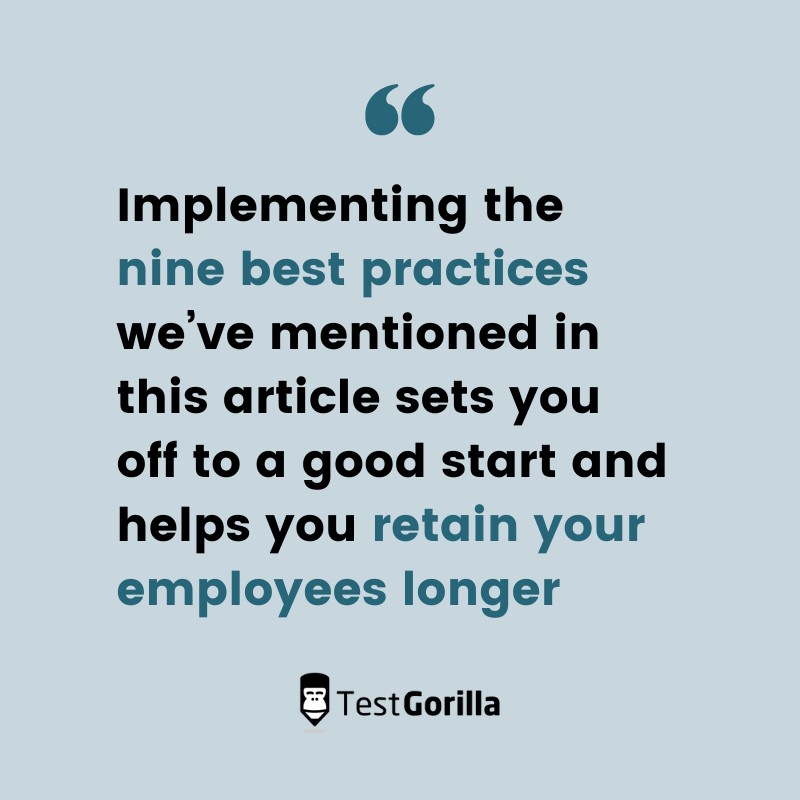You’re already taking care of work-life balance, right? You offer standing desks and a meditation app subscription for your employees so they can be healthier at work, more mindful in their lives, and even do yoga in the office on Fridays.
Isn’t that enough?
Not quite. The sentiment is there, but those are just a couple of perks as opposed to a healthy approach to work.
In 2023, two-thirds of people think that a good work-life balance is more important than pay and employee benefits combined, and 61% of workers are burnt out.
That means those motivated new candidates are still not feeling supported enough in your company to stay.
We understand the confusion, though.
Work-life is a flawed lens. Switching it to life work balance puts things into the right perspective and holds the key to employee happiness.
So let’s set the record straight.
Table of contents
- What is life work balance?
- Why it’s time to move away from work-life balance
- Won’t this shift to life work balance stifle productivity?
- Why is life work balance important?
- How to support your employees: 9 best practices for boosting life work balance
- The TestGorilla perspective: Why we provide our employees with an outstanding life work balance
- Life work balance only works in that order
- Sources
What is life work balance?
Life work balance means life comes first, and work comes second.
Work is just one part of life. Ideally, both the “life” and “work” aspects need to feed into and fuel each other.
A fulfilling life translates to higher energy, inspiration, and productivity at work. Good work, apart from sustaining life, provides an additional level of meaning, achievement, and satisfaction.
It’s not just semantics. We’ve been mixing up the order of importance for long enough, and it shows. Among American employees, 10.4% work 50+ hours per week.
The average time devoted to personal care and leisure among full-time workers is 14.6 hours per day. That includes everything: sleeping, eating, chores, child care, socializing, and relaxing.
So, in other words, after you’re done with all the work – and all the housework, and basic maintenance tasks – you’re left with maybe an hour or two of actual free time in your day-to-day home life.
No amount of time management skills can fix that you’re living your life part-time.
That sounds like the opposite of balance to us.
Why it’s time to move away from work-life balance
We’ve already seen that, on average, full-time workers only get a couple of truly free hours per weekday.
That’s not exactly news, but the pandemic changed the way many employees view what work-life balance means. It made the existing problems urgent while adding some new ones to the mix.
On the employers’ side, the pandemic and the shift to remote working required organizational restructuring and updates to technology infrastructure.
And think of all the “quiets” and all the “greats” of the past few years:
Who can even keep track anymore?
On the employees’ side, the pandemic put things into perspective when it comes to people’s priorities. It also crystallized candidate expectations – and the gap between them and employers’ requirements.
Today, more than ever, the focus needs to be on employee wellbeing and balance between work and personal time.
Why? First of all, because we’re all humans before we’re employers and employees. Yes, work can add meaning and purpose to our lives, but it’s just one aspect of it.
If you think about what makes life worth living, some more important things probably come to mind:
Making memories with family
Reconnecting with friends
Traveling to incredible new destinations
Watching the sunsets
In contrast, if you think about why work is so important, only part of the reason comes from work itself.
The other part is about enabling workers to experience those other, bigger, worthwhile things.
It’s about time we admit this reality. Because, like it or not, employees already know it, and they’re acting on it.
Companies that stubbornly try to make everything about work are losing out on amazing employees who won’t settle.
If that’s you, we understand. You’re probably wondering how the change to prioritizing life will affect business as usual. More precisely…
Won’t this shift to life work balance stifle productivity?
No, it won’t! That’s the best part.
Giving employees more freedom and control actually makes them more productive.
Research says 90% of employees were as (or more) productive working from home, 84% would be happier working from home, and 82% say remote work is better for their mental health.
We’ve also seen staff productivity increase by 40% from working less in Microsoft’s 4-day work week experiment.
Why stand in their way?
Why is life work balance important?
Let’s take a long hard look at the importance of work life balance for both sides: the employees and the employers.
To employees
A lack of life work balance is literally forcing employees out the door. Here’s why they need you to take it seriously:
Reason | Explanation |
Energy and time to spend outside of work | Work should be life-affirming; if they finish their work day and unable to enjoy their life, what’s the point? |
Resources to invest in what matters most | This could be family, hobbies, projects, or health – in any case, the resources they earn directly fuel their lives. |
Ability to enjoy and hold a job long-term | Being burnt out or feeling like they’re not seen as people are issues that lead to disengagement or quitting. |
Personal growth and fulfillment | When work doesn’t come in the way of life, employees have the motivation to excel at it, leading to a sense of accomplishment and purpose. |
No one wants to interview every couple of months or years and switch from one company to another. It’s stressful and draining.
But employees need life work balance to even consider growing roots at a company.
To employers
Here’s what you stand to gain from prioritizing life work balance as the employer:
Reason | Explanation |
More engaged employees | Employees are more engaged when they’re in control of their life work balance. |
Higher and job satisfaction | If they feel empowered to tackle responsibilities and schedule them around family obligations, they’re less likely to quit and find a new job. |
Healthy company culture | Trusting colleagues to pull their weight comes easily when everyone is recharged, happy, and motivated. |
Everyone wants to work for an employer who’s known for caring for their employees, so you can expect more motivated candidates at your door | |
Happier clients and better outcomes | Happier employees produce a higher quality of work, which then leads to better relationships with clients and higher profits. |
Life work balance is a win-win situation.
How to support your employees: 9 best practices for boosting life work balance and productivity
Now that you’re on board, let’s discuss the nine things you can change today to make your company a life-affirming place to work.
1. Pay employees fairly
There can’t be balance if people can’t afford everything they need.
Financial instability automatically comes with a side of stress, scrambling for better options, not having needs met, and putting life on hold to grasp for some stable ground.
On the other hand, being paid fairly leads to less stress, higher morale, and increased productivity.[3]
The bare minimum is rarely enough. Paying your employees fairly is a prerequisite of life work balance, which is why it’s number one on our list – it’s a best practice you can’t afford to skip.
2. Flexible working policies
Here we mean remote and hybrid options location-wise, but also schedule flexibility: synchronous (attendance-based) or asynchronous (self-paced).
Across the board, there isn’t a single ideal way to work. However, that doesn’t mean any option will do – flexibility is key to fitting work into each employee’s life.
Here’s why it’s important:
Candidates choose companies that allow flexibility regardless of their own preferences
Flexible options are more inclusive because some people can’t return to office even if they wanted to (e.g. talent with disabilities, international candidates, caregivers)
Others simply prefer not to work in the office because it makes them less productive (common with neurodiverse candidates) or it doesn’t fit their lifestyles (for example, digital nomads)
Hybrid work arrangements enable employees to get the best of both worlds – the convenience and agency of remote work and socialization in the office
The most important thing is to have multiple options and let people choose where to work whenever possible.
Research confirms that people who work in a setting that doesn’t match their preference, like onsite when they’d rather work remotely, have a higher risk of burnout.
Their wellbeing is lower, engagement drops, and they have a higher turnover rate than their co-workers.
3. Unlimited PTO
Letting your employees take off and leave whenever they want sounds scary and impractical.
Luckily, that’s not what unlimited PTO means.
It simply means the focus isn’t on the number of hours employees put in, but rather on their tasks and responsibilities.
When they take care of their workload and announce it ahead of time, there’s no reason employees shouldn’t take as much time off as they need.
In fact, working when they should be focusing on their physical health or personal issues is counterproductive. It breeds presenteeism – employees showing up to work just because they have to, even though they aren’t capable of doing their job at that time.
You guessed it: Presenteeism tanks productivity and lowers employee wellbeing.
Giving staff control over their rest and work times is one of the best things you can do to ensure they work at their best, without illness or their personal lives clouding their concentration.
They don’t have to miss out on life to get the job done.
And being there to spend time with their kids, pursue passion projects, travel the world, or even take all the naps they want is guaranteed to fuel their work performance in return.
4. 4-day work weeks
Again, there’s no reason why employees should be glued to their desks to hit the quota of acceptable time to spend at work.
The 9-5, 40-hour work schedule was designed with the caveat that there’s another person, traditionally a stay-at-home wife, to handle the household chores and childcare – which required full-time hours.
That’s no longer the default setting, and juggling everything by ourselves is impossible. There aren’t enough hours in a day.
A 4-day work week relieves some of the pressure and gives time back to employees, and 92% of staff support this initiative.
5. Tech enablement
Tech enablement means using tools to elevate the workforce wherever possible.
For example, this could mean automating repetitive and life-draining processes that hold your employees back from revenue-driving activities, or simplifying communication and collaboration on creative tasks.
They should spend less time on less important tasks, right?
Giving them the best equipment is the least you can do to set your workforce up for success and increase their job satisfaction because it:
Reduces the amount of time they spend on each task
Reduces the amount of boring, creativity-killing responsibilities on their to-do list
Makes their work feel meaningful and purposeful because they can switch their focus to more challenging tasks
Makes work more enjoyable
Lets them know you value them, their time, and their skills
Gives them more time to spend outside of work
6. Supportive, inclusive workplace culture
Culture sets the tone for everything that happens in your company.
Colleague and customer interactions. Quality of work. Motivation. Productivity. Teamwork. You name it – culture can help it or break it.
Why does this matter?
In a toxic culture where people feel unsafe and like they have to compete, using a benefit can be risky. For example, taking a mental health day when you know your manager expects constant availability and long hours creates pressure and stress.
In a healthy culture where people trust and help each other out, this is a non-issue.
In turn, everything that happens in the company further shapes your culture, so you need to be mindful and proactive about creating an inclusive and cohesive culture that supports all workers.
This entails:
Supporting working parents (of all genders)
Supporting marginalized groups
Working against stigma around mental health and addiction
Making sure everyone feels safe to be themselves and ask for help
Providing ample opportunities for remote workers to connect
Doubling down on the inclusive culture with wellbeing-related benefits like wellness reimbursement
Some of these practices are one-and-done, like putting a policy in place and ensuring it’s adhered to. Others involve ongoing effort, like modeling the right behavior or regularly checking in with employees.
Workplace culture needs to be at the top of your mind already in the hiring stage, especially with the first couple of hires you make. Ensure they are culture adds, and not culture fits.
But in terms of modeling the right behavior, you have to start at the top.
7. Support from senior leadership
We’ve once worked under a manager who took pride in overworking themselves and their team members.
If we ever needed an extension on a deadline or had an issue, all we heard was, “Well, I’m doing even worse, have more responsibilities, and still work all day every day.”
Our conclusion? Never complain, and misery is just part of professional life.
Safe to say that led to many employees burning out and eventually quitting. And the worst part is we know this is a common experience.
Company culture starts from leadership.
If managers model unhealthy behaviors, this sets the tone for the entire company as employees follow suit.
It doesn’t matter if you have an unlimited PTO policy on paper when staff know they aren’t really allowed to take that time off.
To send the right message, you need good managers that model the right behavior.
Take days off. Share experiences. Ask and be open to hearing about employees’ lives outside of work.
This should be a part of their job description. But managers are people, too, so you need to invest in their training and hire leaders who show the adequate soft skills required to lead a team.
In particular, consider their leadership skills, empathy, personal values, and communication.
8. Build respect and trust in the working environment
We’re all about enabling staff, not micromanaging and snooping on them.
The rationale is simple: If you can trust your colleagues to do their jobs, why would you need to control their PTO or count their clicks per hour?
These things are about control, and they’re a ball and chain around your company’s ankle.
What you want to be focusing on are responsibilities and outcomes, and asking questions like:
How do you help your employees achieve their daily, monthly, and yearly goals?
What about outside of work?
How do you ensure they’re focused and having a good time working at your company?
How do you motivate them?
These questions lead you to the right answers and build a healthy culture where employees trust leadership and each other.
According to a BetterUp study, the positive effects of building trust and connection include:
Greater goal attainment (34%)
Boosting wellbeing (36%)
Increasing positive work relationships (59%)
Improving professional growth (92%)
9. Recognize that healthy life work balances are different for everyone
Give your employees a say in how they build their workday as long as they perform and hit targets.
There’s no need to fit everyone in the same mold.
Diversity in the workplace is much more fruitful. Innovative ideas, different perspectives, and unique abilities enrich the company and banish stagnant dynamics. Diversity should be celebrated.
But you need to take your talent as a whole package.
On the flip side of all those diversity benefits are unique challenges and needs that your company needs to accommodate.
A working dad might not have the same needs as an autistic employee, or the same preferences as a colleague entering menopause – and that’s perfectly okay.
As long as you provide more than one option and ask your talent what they need, you can guarantee everyone feels welcome.
The TestGorilla perspective: Why we provide our employees with an outstanding life work balance
The areas companies can improve are the same areas TestGorilla has faced similar challenges and sought solutions to become a better workplace – the kind where we would like to work.
It all goes back to company values.
TestGorilla firmly believes in taking ownership of our work outcomes. We want to celebrate colleagues’ achievements and trust them to excel at their jobs. But that can only happen if their jobs are fulfilling and accommodating of their lives outside of work.
So how do you become that sort of a workplace?
You re-examine your requirements and your own relationship to work.
For example, we like to be able to have dinner with our families on weekdays, seize the sparse daylight hours in wintertime, and do chores at convenient times to save the weekends for relaxation.
As it turns out, so do our employees.
So we prioritize these freedoms in practice by offering:
Flexible or asynchronous remote work
A strong, positive, inclusive culture
Inclusive leadership
Nontraditional benefits like unlimited PTO and free wellness sessions every three weeks
Upskilling and development opportunities and budget
We’re not perfect either, but these things have already made a huge difference for us.
To confirm this, we’ve asked our employees to give us their honest thoughts and their favorite parts about working at TestGorilla now.
Here’s what they said about the importance of work life balance:
Nadia Vatalidis (Head of People & Culture): To me, it’s about integrating your work into your life and not the other way around. Remote work, more than other operating models, really enables this!
Lauren Salton (Talent Acquisition Specialist): It’s not just about the remote work – because I have worked remotely before whereby the expectation is being actively at your desk from 9-5. I would say that the A-sync, flexibility is what makes the balance happen. Knowing that I can take time during the day to do something, whether that be helping a friend paint a rainbow on her little daughter’s first real bedroom (yep that happened a couple of weeks ago) or getting out for some exercise, and not feeling guilty because I know my work is getting done. That is priceless.
I would also say that by being able to fit mundane things into my working week (car repairs, doctor’s appointments, etc.) means I value my weekends much more than I used to do.
Kim Serverinson (Head of Assessments): I have been experimenting with the idea of work-life “blend,” which perhaps links to Nadia’s idea of integration. This has been increasingly important as a parent – you can’t stop being a mum between 9-5 / M-F!
Sheena Muirden (Content Marketing Coordinator): I love that TestGorilla offers me total flexibility in my working hours and champions responsibilities over hours – as long as my work is being done, it doesn’t matter if I start work at 8 am or 10 am. As a single mum, this makes a huge difference because it enables me to work around the hours my son is at nursery, and I can start/finish later when he is with his dad. It also makes it easier for me to get things done outside of work – if I need to go for an eye test, I can go during “normal” work hours, which means I can get an appointment easier and I don’t have to drag my two-year-old with me on the weekend. As Lauren mentioned, this frees up my weekend so I can relax and spend quality time with my son instead. Plus, having unlimited PTO means I can take time off when I need to without worrying – which is great if my son is sick and needs to stay at home, if I want to take a vacation, or if I need a mental health break.
Now over to you.
Life work balance only works in that order
People don’t exist to work. That goes both for employers and employees.
It’s time we switch from work life to life work balance and acknowledge the place of jobs in our lives.
Implementing the nine best practices we’ve mentioned in this article sets you off to a good start and helps you retain your employees longer.
But beware: Jobs with the best work life balance come with tons of new candidates in the talent pool.
You’ll need a way to fairly judge and compare all of them – pre-employment testing helps you there.
Sources
1. “Revealed: The most important aspects of a job”. (May 21, 2022). Ciphr. Retrieved April 11, 2023. https://www.ciphr.com/the-most-important-aspects-of-a-job/
2. “The State of Burnout 2020”. (2020). Blind. Retrieved April 11, 2023. https://usblog.teamblind.com/wp-content/uploads/2020/03/TheStateof-Burnout2020.pdf\\
“3. Why Paying Employees a Fair or Living Wage Makes Sense”. (May 2022). Hopkins HR. Retrieved April 14, 2023. https://hopkinshr.com/why-paying-employees-a-fair-or-living-wage-makes-sense/
4. Kenton, Will. (January 31, 2023). “Presenteeism”. Investopedia. Retrieved April 14, 2023. https://www.investopedia.com/terms/p/presenteeism.asp
5. “Chapter 5: Americans’ Time at Paid Work, Housework, Child Care, 1965 to 2011”. (March 14, 2013). Pew Research Center. Retrieved April 14, 2023.
Related posts
Hire the best candidates with TestGorilla
Create pre-employment assessments in minutes to screen candidates, save time, and hire the best talent.
Latest posts
The best advice in pre-employment testing, in your inbox.
No spam. Unsubscribe at any time.

Hire the best. No bias. No stress.
Our screening tests identify the best candidates and make your hiring decisions faster, easier, and bias-free.
Free resources
This checklist covers key features you should look for when choosing a skills testing platform
This resource will help you develop an onboarding checklist for new hires.
How to assess your candidates' attention to detail.
Learn how to get human resources certified through HRCI or SHRM.
Learn how you can improve the level of talent at your company.
Learn how CapitalT reduced hiring bias with online skills assessments.
Learn how to make the resume process more efficient and more effective.
Improve your hiring strategy with these 7 critical recruitment metrics.
Learn how Sukhi decreased time spent reviewing resumes by 83%!
Hire more efficiently with these hacks that 99% of recruiters aren't using.
Make a business case for diversity and inclusion initiatives with this data.























